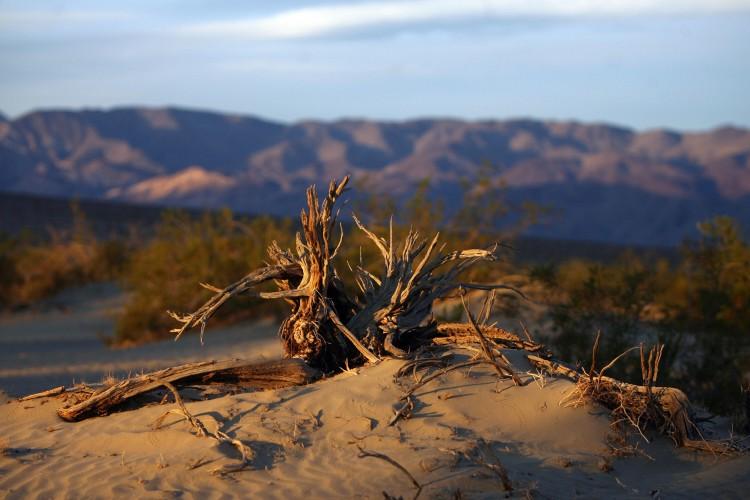The hottest place on Earth is Death Valley, in California. The record temperature of 56.7 degrees Celsius (134 degrees Fahrenheit) was recorded in October 1913.
Death Valley, northwest of Las Vegas and northeast of Los Angeles, is known as a dry and arid desert. Yet within its boundaries are springs, and even peaks. The peaks sometimes have snow and ice on them from December to May.
Also, more than 1,000 species of plants and a range of animals live here, though the animals are mostly nocturnal (sleeping during the day and roaming during the night).
Visiting Death Valley is interesting. The silence and stillness take visitors by surprise. Some favor a drive around, peering out the window at the different sights. Others prefer hiking; some places are inaccessible by car.
How to get there: From the west, take US 395 or Route 14 to highways connecting to the park. For directions from the east, visit the park website. Also, make sure to carry a map with you—GPS systems have a bad reputation of getting people lost in Death Valley, according to Recreation.gov. It’s not safe to rely on them.
Where to Stay:
- Furnace Creek Resort
- Furnace Creek Inn
- The Ranch at Furnace Creek
Stovepipe Wells Village
Panamint Springs Motel
Campgrounds
Minding the Land
Sarah Craighead, former superintendent of the park, says tending the large park means a journey every day.
“It can take me all day to get to another part of the park,” she said. “You can stand in Death Valley and look around and see only the park; you can’t see outside the boundary.”
And watching over the park entails living within its boundaries.
“It’s very remote. We can’t just run out to the mall or go to the movies,” Craighead said, “but we have an active social life. We’re always thinking up things to do.”
Recommended: The Five Coldest and Hottest Places on Earth
Because about 95 percent of Death Valley is a designated wilderness area, much of it doesn’t have roads. The name Death Valley came after a group of pioneers got lost in the valley in the winter of 1849-1850 and one of them died, according to the National Park Service. The rest thought they were going to die; when they made it out safely, one of the men turned back and said “goodbye, Death Valley.”
Flora and Fauna
Animals living in Death Valley include:
- Desert Tortoises
- Lizards, such as sagebrush lizards
- Snakes, including the California king snake
- Toads, including the red spotted toad
- Dozens of species of birds, including thrushes, wrens, and cardinals
- Bats, including the western big-eared bat
- Desert shrews
- Kangaroo rats (and other rats and mice)
- Squirrels, such as California ground squirrels
- Black-tailed jacrabbits
- The Salt Creek pupfish
- Coyotes
- Badgers
- Mountain lions
- Horses
- Desert bighorn sheep
- Butterflies, including the indra swallowtail
Plant life includes many species endemics to only Death Valley:
- Golden Carpet
- Napkin Ring Buckwheat
- Rock Lady
Other flowers, including partial endemics, include:
- Death Valley Sticky Ring
- Panamint Daisy
- Death Valley Sage
Things to do
Outdoor activities include:
- Hiking
- Biking
- Backcountry camping
- Driving around
- Biking and mountain biking
- Birdwatching
- Guided tours
- Visiting the Death Valley ghost towns
Indoor options:
- Furnace Creek Visitor Center
- Scotty’s Castle and visitor center
- Borax Museum
Areas
Canyons
Colored Rocks
Panoramas from Dante’s View
Badwater Basin
‘Hottest Place’ Controversy
A surprising change to the label of the hottest place on Earth happened late last year. An investigating committee found the temperature recorded in 1922 in El Azizia (in modern-day Libya) had major problems—the biggest being that “a new and inexperienced observer,” not trained, “improperly recorded the observation.”
El Azizia is no longer the recognized hottest place. Now it is Furnace Creek Ranch in California’s Death Valley.
“Even when it wasn’t officially holding the record, Death Valley has never slacked when it comes to hot days,” writes Randy Banis, editor of DeathValley.com, an online newsletter. “In the summer of 2001, a temperature of 100 Fahrenheit or above was logged 154 days in a row. The summer of 1996 (considered the hottest in the Valley’s recorded history) had 40 days with a temperature over 120 Fahrenheit and 105 days with a temperature over 110 Fahrenheit. ”
Yet, according to recent research, perhaps neither place should hold the title. “Most of the places that call themselves the hottest on Earth are not even serious contenders,” said Steve Running of the University of Montana, according to NASA.
Running was involved in a seven-year study that concluded the Lut Desert in Iran is the world’s hottest place. But recording extremely hot temperatures is tough.
Recommended: Coldest Place on Earth
“The Earth’s hot deserts—such as the Sahara, the Gobi, the Sonoran, and the Lut—are climatically harsh and so remote that access for routine measurements and maintenance of a weather station is impractical,” said David Mildrexler, also at the University of Montana. “The majority of Earth’s hottest spots are simply not being directly measured by ground-based instruments.”
That’s why the team used satellites, scanning the planet’s surface and filling in gaps in global temperatures measurements. In five of the seven years of study, the highest surface temperature on Earth was found in the Lut Desert. Once a temperature of 70.7 Celsius (159.3 Fahrenheit) was recorded.
For now, though, the official hottest place is Death Valley.






